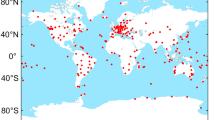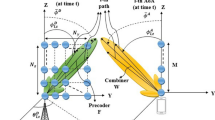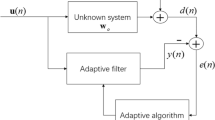Abstract
Recently, a discrete-time version of the rake receiver has been proposed, as an alternative to the conventional continuous-time rake receiver, to overcome the need for complex path searching and tracking procedures. This discrete-time version is able to tackle diffuse multipath channels, avoiding by the way any required knowledge on the delays associated to the most significant channel paths. Unfortunately, it has been found to be very sensitive to channel estimation quality and leads to a significant degradation in performance in practice. To reduce this degradation, we propose and investigate in this paper an optimum structure of this discrete-time rake receiver, according to the maximuma posteriori criterion. Derived from an uncorrelated version of the discrete-time channel, provided by the Karhunen-Loève orthogonal expansion theorem, this structure requires for its operation more or less precise estimates of the discrete-time channel statistics. Consequently, for a precise characterization and evaluation of the enhancement in performance provided by this new structure, we propose to use both perfect and estimated statistics of the discrete-time channel. The estimated statistics, derived in conformity with the maximum likelihood criterion, are carried on a symbol-by-symbol basis. The performance of this new structure is evaluated through theoretical and simulation results and compared to that of the conventional discrete-time rake receiver with perfect and estimated discrete-time channel state information. In this evaluation, a diffuse multipath Rayleigh fading propagation channel with classical Doppler power spectrum and exponentially decaying multipath intensity profile is used.
Résumé
Récemment, une version à temps discret du récepteur en râteau a été proposée, comme alternative à la version classique à temps continu, pour éviter l’emploi de procédures complexes de recherche et de poursuite de trajets. Cette version à temps discret est capable de traiter des canaux multitrajets diffus, rendant ainsi inutile la connaissance des délais associés aux trajets les plus significatifs du canal. Malheureusement, elle s’est révélée être très sensible à la qualité de l’estimation du canal et conduit en pratique à une dégradation significative en performance. Pour réduire cette dégradation, on propose et on examine dans ce papier une structure optimale de ce récepteur en râteau à temps discret relativement au critère du maximuma posteriori. Dérivée à partir d’une version décorrélée du canal à temps discret, fournie par le théorème de développement orthogonal de Karhunen-Loève, cette structure nécessite pour son fonctionnement une estimation plus ou moins précise des statistiques du canal à temps discret. Par conséquent, on propose d’utiliser à la fois des statistiques parfaites et des statistiques estimées du canal à temps discret pour une estimation et une évaluation précises de l’amélioration apportée par cette nouvelle structure. Les statistiques estimées, dérivée selon le critère du maximum de vraisemblance, sont effectuées symbole par symbole. Les performances de cette nouvelle structure sont évaluées à travers des résultats théoriques et des résultats de simulation et comparées à celles du récepteur en râteau à temps discret classique avec connaissance parfaite ou estimation réaliste de l’état du canal à temps discret. Dans cette évaluation, un canal multitrajet diffus, avec évanouissements de Rayleigh possédant un spectre de puissance Doppler de forme classique et un profil d’intensité multitrajet à décroissance exponentielle, est utilisé.
Similar content being viewed by others
References
Proakis (J. G.), Digital Communications,McGraw-Hill, New York 4th edition (2001).
Boujemaa (H.),Siala (M.), Récepteurs en Râteau pour les Systèmes à Étalement de Spectre par Séquence Directe,Annals of Telecommunications, (2001),56, no 5–6, pp. 291–305.
Viterbi (A.J.),cdma: Principles of Spread Spectrum Communication,Addison-Wesley (1995).
Zhang (Q.),Huang (J.),Xie (Y.), High Resolution Delay Estimation,Proceedingstencon’93, (1993), pp. 579–583.
Van Nee (R.D.J.), The Multipath Estimation Delay Lock Loop,International Symposium on Spread Spectrum Techniques and Applications, December 1992), pp. 39–42.
Boujemaa (H.),Fratu (O.),Siala (M.),Loubaton (P.), On the Performance of a Discrete-Time Rake,Personal Indoor and Mobile Radio Communications, London (September 2000), pp. 949–953.
Siala (M.), Maximuma Posteriori Fast Fading Channel Estimation Based Exclusively on Pilot Symbols,Annals of Telecommunications, (September/October 2001),56, no 9–10, pp. 569–586.
Ling (W.),Silventoinen (M.),Honkasalo (Z.), A New Algorithm for Estimating Mobile Speed at thetdma-Based Cellular System,ieee46th Vehicular Technology Conference, 1996, (28 April–1 May 1996),2, pp. 1145–1149.
Narasimhan (R.),Cox (D.C.), Speed Estimation in Wireless Systems Using Wavelets,ieeeTransactions on Communications, (September 1999),47, no 9, pp. 1357–1364.
Xiao (C.),Mann (K.D.),Olivier (J.C.), Mobile Speed Estimation fortdma-Based Hierarchical Cellular Systems,ieeeTransactions on Vehicular Technology, (July 2001),50, no 4, pp. 981–991.
Narasimhan (R.),Cox (D. C.), Estimation of Mobile Speed and Average Received Power in Wireless Systems Using Best Basis Methods,ieeeTransactions on Communications, (December 2001),49, no 12, pp. 2172–2183.
Kirsch (M.),Berens (F.), Mobile Speed Estimation for 3G Mobile Radio Systems Using the Normalized Autocovariance Function,International Zurich Seminar on Broadband Communications, 2002, (February 19–21, 2002), pp. 48-1–48-4.
3GPP Technical Specification TS 25.211, Physical Channels and Mapping of Transport Channels onto Physical Channels (FDD), http://www.3gpp.org. (December 2002).
Yang (J.-F.),Kaveh (M.), Adaptive Eigensubspace Algorithms for Direction or Frequency Estimation and Tracking,ieeeTransactions on Acoustics, Speech and Signal Processing, (February 1988),36, no 2, pp. 241–251.
Degroat (R.D.),Roberts (R.A.), Efficient, Numerically Stabilized Rank-One Eigenstructure Updating,ieeeTransactions on Acoustics, Speech and Signal Processing, (February 1990),38, no 2, pp. 301–316.
Comon (P.),Golub (G.H.), Tacking a Few Extreme Singular Values and Vectors in Signal Processing,Proceedings of theieee, (August 1990), 78, no 8, pp. 1327–1343.
Yu (K.-B.), Recursive Updating the Eigenvalue Decomposition of a Covariance Matrix,ieeeTransactions on Signal Processing, (May 1991),39, no 5, pp. 1136–1145.
Champagne (B.), Adaptive Eigendecomposition of Data Covariance Matrices Based on First-Order Perturbations,ieeeTransactions on Signal Processing, (October 1994),42, no 10, pp. 2758–2770.
Champagne (B.),Liu (Q.-G.), Plane Rotation-Based EVD Updating Schemes for Efficient Subspace Tracking.ieeeTransactions on Signal Processing, (July 1998),46, no 7, pp. 1886–1900.
Xu (Z.), Perturbation Analysis for Subspace Decomposition With Applications in Subspace-Based Algorithms,ieeeTransactions on Signal Processing, (November 2002),50, no 11, pp. 2820–2830.
Riou (C.),Chonavel (T.),Cochet (P.-Y), Adaptive Subspace Estimation — Application to Moving Sources Localization and Blind Channel Identification,ieeeInternational Conference on Acoustics, Speech, and Signal Processing, 1996 (icassp-96), (7–10 May 1996),3, pp. 1648–1651.
Riou (C.),Chonavel (T.), Fast Adaptive Eigenvalue Decomposition: a Maximum Likelihood Approach,ieeeInternational Conference on Acoustics, Speech, and Signal Processing, 1997 (icassp-97), (21–24 April 1997),5, pp. 3565–3568.
Siala (M.), Récepteur en Râteau Itératif et Procédé de Réception Correspondant, French Patent no 98 10578, (August 20, 1998).
Siala (M.),Jaffrot (E.), Récepteur à Multiplexage par Répartition en Fréquences Orthogonales avec Estimation Itérative de Canal et Procédé Correspondant, French patent no 99.11415, (September 13, 1999).
Siala (M.),Jaffrot (E.), Procédé d’Estimation Optimale d’un Canal de Propagation Reposant Uniquement sur les Symboles Pilotes et Estimateur Correspondant, French patent no 00.11715, (September 14, 2000).
Hara (S.),Prasad (R.), Overview of Multicarriercdma,ieeeCommunications Magazine, (December 1997),35, no 12, pp. 126–133.
Bottomley (G. E.),Ottosson (T.),Wang (Y.-P.E.), A GeneralizedRake Receiver for Interference Suppression,ieeeJournal on Selected Areas in Communications, (August 2000),18, no 8, pp. 1536–1545.
Bottomley (G.E.),Ottosson (T.),Wang (Y.-P.E.), A GeneralizedRake Receiver fords-cdma Systems,ieee51st Vehicular Technology Conference 2000 Spring, (May 15–18, 2000),2, pp. 941–945.
Wang (Y.-P.E.),Bottomley (G.E.), GeneralizedRake Reception for Cancelling Interference from Multiple Base Stations,ieee52nd Vehicular Technology Conference 2000 Fall, (September 24–28, 2000),5, pp. 2333–2339.
Wang (Y.-P.E.),Bottomley (G.E.),cdma Downlink System Capacity Enhancement through GeneralizedRake Reception,ieee54th Vehicular Technology Conference 2001 Fall, (October 7–11, 2001),2, pp. 1177–1181.
Jakes (W. C.), Microwave Mobile Communications,New York, Wiley, 1974.
Author information
Authors and Affiliations
Rights and permissions
About this article
Cite this article
Siala, M. Maximuma posteriori decorrelating discrete-time rake receiver. Ann. Télécommun. 59, 374–411 (2004). https://doi.org/10.1007/BF03179703
Received:
Accepted:
Issue Date:
DOI: https://doi.org/10.1007/BF03179703
Key words
- Optimum receiver
- Aposteriori probability
- Discretization
- Rayleigh Fading
- Multipath propagation
- Discrete time filter
- Multichannel circuit
- Direct sequence spread spectrum
- Maximum likelihood
- Statiscical estimation
- Decorrelation




